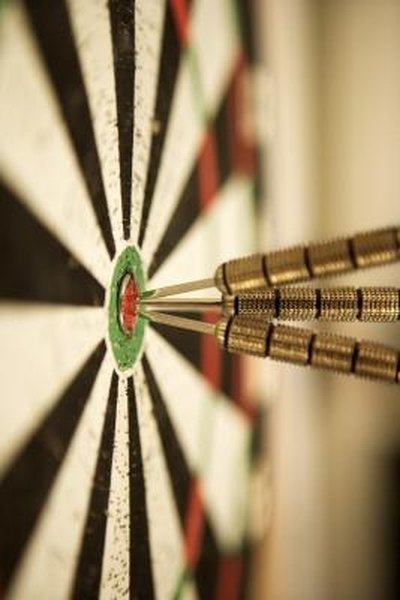
Hanging a corkboard behind a dartboard will help protect the wall behind the board should the dart thrower miss his intended mark. This task is easy and well-worth the effort for any home or garage that has a dartboard. All the materials can be purchased relatively inexpensively at any local hardware store.
Items you will need
One sheet of 1/2 inch plywood
6 square feet of 1-inch thick corkboard (36 inches by 36 inches)
12 linear feet of 1 inch by 1 inch wood trim (optional)
4 foot by 4 foot piece of felt (optional)
Rubber cement
Finish nails, if adding wood trim
Wood screws
Circular saw
Miter saw, if adding wood trim
Utility knife
Tape measure
Chalk line or framing square
Pencil
4-foot level
Drill
Small paint roller (optional for applying rubber cement)
Finish hammer
Cut a 36-by-36 inch square from the plywood using the circular saw.
Apply rubber cement or wood glue evenly across the plywood, covering it completely. Press the corkboard onto the plywood, making sure that the edges line up and are flush. Clamp the corners of the cork to the plywood to ensure the pieces do not move during the drying process. If you do not have clamps, place a heavy object on top of the cork. Follow the recommended drying time on the glue instructions. After the glue is dry, trim the edges of the cork with a utility knife if necessary.
Cover the cork with felt (optional) or simply hang the board backer as is. To cover with felt, apply a coat of rubber cement to the surface of the corkboard. Stretch the felt over the glue, making sure that there are no wrinkles. Once the glue dries, cut the excess felt with the utility knife or scissors.
Frame out the edges with the wood trim (optional). Cut the top and bottom pieces to 36 inches. Cut the side pieces to 34 inches -- 2 inches shorter because of the top and bottom trim. Attach the top and bottom pieces to the front of the backing board using 2-1/4 inch finish nails, making sure that the edges are flush. Attach the side pieces the same way.
Locate the center of two studs in the wall and mark. Measure up from the ground 5 feet 8 inches along each stud and mark -- according to dart regulations that is where the center of the dart board will be. From there, measure up 18 inches (half the height of the board backer) and put another mark. Use a 4-foot level to draw a level line between the two marks to indicate where the top of the backer board will be placed.
Drill holes in the board backer: two at the top and bottom, and three along each side. Space the holes evenly so they will align in the center of the studs in the wall.
Hold the backer board to the wall, making sure the top aligns with the vertical line. Screw the backer board to the wall. The screws need to go into the stud at least 1/2 inch, so use the appropriate length screw based on whether or not you used the wood trim.
Warnings
- When using power tools, follow the safety guidelines and be careful.
Tips
- If you can't find 1-inch corkboard, glue together several thinner corkboards until the desired thickness is reached.
- A 4-foot metal level makes for a good straight edge when cutting the cork. If no level is available, a 2-by-4 board works well also.
- Using a small paint roller or brush will spread the glue faster than the small brush that comes with the rubber cement.
- A miter saw could be used to create a 45-degree cut at the corners of the trim.
References
- Interview with Gary Russell; dart team member for The Rail Pub; 2011
- Dart Rules: Hanging a Dart Board
Tips
- If you can't find 1-inch corkboard, glue together several thinner corkboards until the desired thickness is reached.
- A 4-foot metal level makes for a good straight edge when cutting the cork. If no level is available, a 2-by-4 board works well also.
- Using a small paint roller or brush will spread the glue faster than the small brush that comes with the rubber cement.
- A miter saw could be used to create a 45-degree cut at the corners of the trim.
Warnings
- When using power tools, follow the safety guidelines and be careful.
Writer Bio
Shawndra Russell started freelancing professionally for several outlets in 2010, covering arts and entertainment, culture and society, health and fitness, sports and recreation, and travel. Russell earned her Bachelor of Arts in English from Ashland University and her Master of Arts in English from Marshall University.



